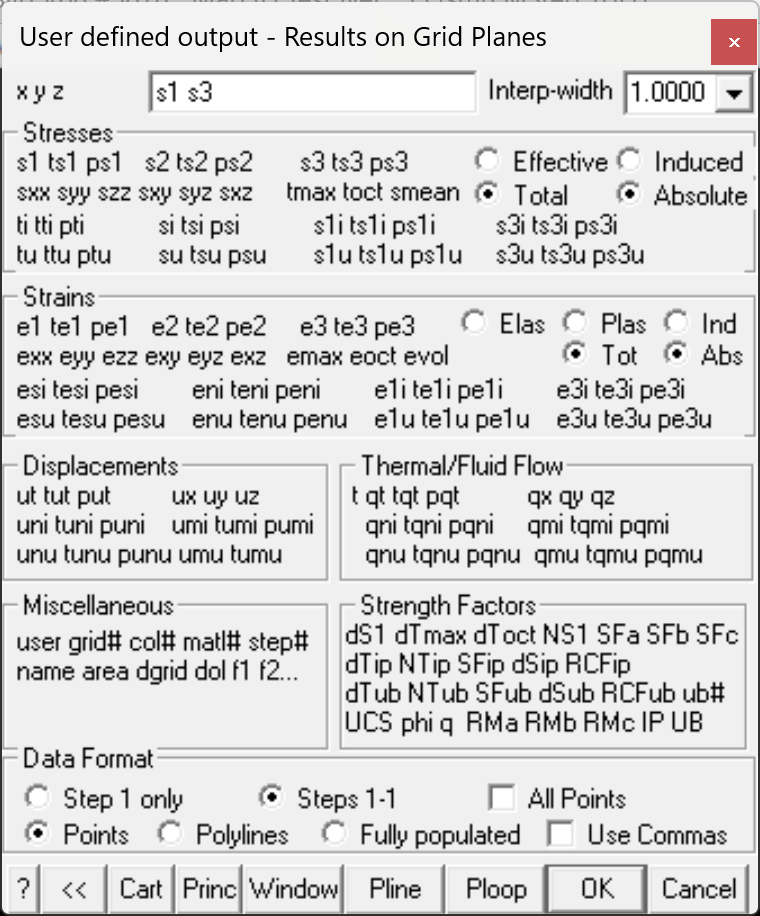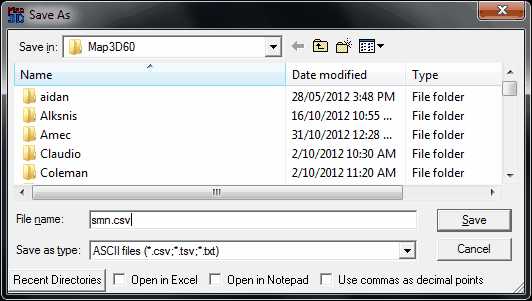Dumps selected grid components to a text file (*.txt) in a user controlled format.
By default all points on all grids are dumped. If you want to dump only a selected set of points use the window function defined below.

Upon selecting the desired data then OK, you will be prompted for a file name to save the data.
You can select CSV (comma separated/delimited data), TSV (tab separated/delimited data) or TXT (space sepat\rated/delimited data).
You can also specify to automatically open the file in Excel or Notepad.
Note that you should not use CSV files with commas as decimal points.

Stresses:
s1 ts1 ps1 major principal stress σ1 its trend and plunge.
s2 ts2 ps2 intermediate principal stress σ2 its trend and plunge.
s3 ts3 ps3 minor principal stress σ3 its trend and plunge.
sxx syy szz sxy syz sxz Cartesian stress components.
tmax maximum shear stress τmax = ½ ( σ1 - σ3 )
toct octahedral shear stress τoct = ¹/3 [( σ1 - σ2 )² + ( σ2 - σ3 )² +( σ3 - σ1 )²]½
smean mean stress σmean = ¹/3 ( σ1 + σ2 + σ3 )
ti tti pti maximum shear stress in the grid plane, its trend and plunge.
si tsi psi normal stress in the grid plane, its trend and plunge.
s1i ts1i ps1i maximum stress tangential to the grid plane, its trend and plunge.
s3i ts3i ps3i minimum stress tangential to the grid plane, its trend and plunge.
tu ttu ptu maximum shear stress in the ubiquitous-plane, its trend and plunge.
su tsu psu stress normal to the ubiquitous plane, its trend and plunge.
s1u ts1u ps1u maximum stress tangential to the ubiquitous plane, its trend and plunge.
s3u ts3u ps3u minimum stress tangential to the ubiquitous plane, its trend and plunge.
The orientation of the ubiquitous-plane is specified in
![]() Plot > Strength Factors > Ubiquitous Parameters
Plot > Strength Factors > Ubiquitous Parameters
Effective/Total effective stress or total stress components. These options are only used in Map3D Thermal-Fluid Flow, as this code allows for calculation of steady state pore pressure distributions.
Induced/Absolute Induced stress is the stress without the pre-mining stress contribution. This represents the stress change since the pre-mining condition. Absolute stress is the stress including the pre-mining stress contribution.
Strains:
e1 te1 pe1 major principal strain ε1 its trend and plunge.
e2 te2 pe2 intermediate principal strain ε2 its trend and plunge.
e3 te3 pe3 minor principal strain ε3 its trend and plunge.
exx eyy ezz exy eyz exz Cartesian strain components.
emax maximum shear strain εmax = ½ ( ε1 - ε3 )
eoct octahedral shear strain εoct = ¹/3 [( ε1 - ε2 )² + ( ε2 - ε3 )² +( ε3 - ε1 )²]½
evol volumetric strain εvol = ( ε1 + ε2 + ε3 )
esi tesi pesi maximum shear strain in the grid plane, its trend and plunge.
eni teni peni normal strain in the grid plane, its trend and plunge.
e1i te1i pe1i maximum strain tangential to the grid plane, its trend and plunge.
e3i te3i pe3i minimum strain tangential to the grid plane, its trend and plunge.
esu tesu pesu maximum shear strain in the ubiquitous-plane, its trend and plunge.
enu tenu penu strain normal to the ubiquitous plane, its trend and plunge.
e1u te1u pe1u maximum strain tangential to the ubiquitous plane, its trend and plunge.
e3u te3u pe3u minimum strain tangential to the ubiquitous plane, its trend and plunge.
Elastic/Plastic/Total elastic, plastic or total strain components. These options are only used in Map3D Non-Linear, as this code allows for calculation of non-linear strains.
Induced/Absolute Induced strain is the strain without the pre-mining contribution. This represents the strain change since the pre-mining condition. Absolute strain is the strain including the pre-mining strain contribution.
Displacements:
ut tut put total displacement, its trend and plunge.
ux uy uz Cartesian displacement components.
uni tuni puni displacement normal to the grid plane, its trend and plunge.
umi tumi pumi maximum displacement tangential to the grid plane, its trend and plunge.
unu tunu punu displacement normal to the ubiquitous plane, its trend and plunge.
umu tumu pumu maximum displacement tangential to the ubiquitous plane, its trend and plunge.
Flow:
t temperature/head.
qt tqt pqt total flow, its trend and plunge.
qx qy qz Cartesian flow components.
qni tqni pqni displacement normal to the grid plane, its trend and plunge.
qmi tqmi pqmi maximum displacement tangential to the grid plane, its trend and plunge.
qnu tqnu pqnu displacement normal to the ubiquitous plane, its trend and plunge.
qmu tqmu pqmu maximum displacement tangential to the ubiquitous plane, its trend and plunge.
Strength:
•ds1 excess major principal stress Δσ1 = σ1 - ( UCS + q σ3 )
•dtmax excess maximum shear stress Δτmax = ½(σ1 - σ3) - [ UCS + ½(σ1+σ3) (q-1) ]/(q+1) = [σ1 - ( UCS + q σ3) ]/(q+1)
•dtoct excess octahedral shear stress Δτoct = τoct - [ UCS + (q–1) σmean ] √(2) /(q+2)
•NS1 probability using the Normal distribution N(Δσ1 /std)
•SFA Strength/Stress can be determined as ( UCS + q σ3 )/ σ1
•SFB Strength/Stress can be determined as ( UCS + q σ3 - σ3 )/(σ1 - σ3)
•SFC Strength/Stress can be determined as [ UCS + ½(σ1+σ3) (q-1) ]/[ ½(σ1 - σ3)(q+1) ]
•dTip excess in-plane shear stress Δτip = τip - [ Cohesion + σip tan(φ) ]
•NTip probability using the Normal distribution N(Δτip /std)
•SFip Strength/Stress can be determined as [ Cohesion + σip tan(φ) ] / τip
•dSip excess in-plane wall stress Δσip = [ 3 σ1i - σ3i ] - UCS
•RCFip Rock Condition Factor for the in-plane wall stress RCFip = [ 3 σ1i - σ3i ]/UCS
•dTub excess ubiquitous-plane shear stress Δτub
•NTub probability using the Normal distribution N(Δτub /std)
•SFub Strength/Stress can be determined as [ Cohesion + σub tan(φ) ] / τub
•dSub excess ub-plane wall stress Δσub = [ 3 σ1ub - σ3ub ] - UCS
•RCFub Rock Condition Factor for the ub-plane wall stress RCFip = [ 3 σ1ub - σ3ub ]/UCS
•UB# Plots the UB set number (1, 2 or 3) that has the largest value of Δτub
•UCS phi q Mohr-Coulomb strength parameters defined using ![]() Plot > Strength Factors > Rockmass Strength Parameters note that these parameters are only defined if you have specified the Mohr-Coulomb or Druker-Prager strength criterion
Plot > Strength Factors > Rockmass Strength Parameters note that these parameters are only defined if you have specified the Mohr-Coulomb or Druker-Prager strength criterion
•sc Hoek-Brown strength parameter defined using ![]() Plot > Strength Factors > Rockmass Strength Parameters note that this parameter is only defined if you have specified the Hoek-Brown strength criterion
Plot > Strength Factors > Rockmass Strength Parameters note that this parameter is only defined if you have specified the Hoek-Brown strength criterion
Miscellaneous:
user User defined value.
grid# the number of the grid where the point is located.
matl# the number of the material within which the point is located. The host material is material number 1. In problems where multiple materials are used, results may be calculated in an alternate material zone.
step# the mining step number.
name the name of the grid.
area the area of the grid patch adjacent to the point picked.
dgrid distance to the nearest surface from each grid point.
dol distance to the nearest grid Dgrid divided by the grid spacing Lgrid.
f1 f2... user defined material parameters. These can be defined using Plot > Properties > Material Properties > User defined Parameters.
Data Format:
Points data will be written out as a series of points with one point per line:
x1 y1 z1 values1
x2 y2 z2 values2
x3 y3 z3 values3
x4 y4 z4 values4
...
where xi yi zi represent the coordinates of each point,
valuesi represents the values of the list of user selected components at each point. The user defined values will be listed as a comment line (i.e. a line beginning with an asterisk "*") at the beginning of the file.
Polylines data will be written out as a series of polylines in PNT file format
x1 y1 z1 3 values1
x2 y2 z2 2 values2
x3 y3 z3 2 values3
x4 y4 z4 2 values4
...
where xi yi zi represent the coordinates of each point,
3 indicates that this point is the beginning of a new line,
2 indicates that this point is a continuation of the same line,
valuesi represents the values of the list of user selected components at each corner of the polyline. The user defined values will be listed as a comment line (i.e. a line beginning with an asterisk "*") at the beginning of the file.
Fully Populated data will be written out such that all data will be on a regular sized grid.
Use Commas data will be written out with commas in place of decimal points.
Other:
<< to shrink the dialogue box to small size
>> to expand the dialogue box to large size
Cartesian configures for output of cartesian stress components.
Principal configures for output of principal stress components.
Window activates a graphical pick window.
•You will be prompted to select the two corners of the window by picking each with a single mouse click.
•Only grid points enclosed within the window will be included in the dump.
•If you do not use this function all points on all grids are dumped.
•To view the location of the actual contour points enable display of trajectories (Plot > Options > Trajectories). The contour points are located where the trajectories are drawn.
Polyline activates a graphical pick polygon. You will be prompted to select a series of corners to define a polygon by picking each with a single mouse click:
•You must hold the Shift-key down while selecting these points.
•If you define a closed polygonal shape - those contour points enclosed in the polygon will be included.
•If you define an open polygonal shape - a series of points along the length of the polyline will be included.
•To view the location of the actual contour points enable display of trajectories (Plot > Options > Trajectories). The contour points are located where the trajectories are drawn.
•Simple rectangular widow shapes can be defined by holding the Shift-key and dragging open a window (same as with the Window button).